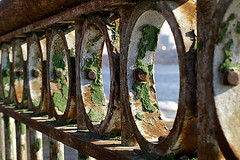 Corrosion (Photo credit: LearningToSee)Climate change impact on building surfaces and facades (12 page pdf, Terje Grøntoft, International Journal of Climate Change Strategies and Management, 2011)
Corrosion (Photo credit: LearningToSee)Climate change impact on building surfaces and facades (12 page pdf, Terje Grøntoft, International Journal of Climate Change Strategies and Management, 2011)As more and more countries fail to meet the international agreements to reduce carbon emissions in a timely manner – either in terms of absolute emissions (China, USA and others) or per capita (Canada, Australia and others)- attention now needs to turn to adapting to climate change coming in the next few decades and especially to cities. The article under review today looks at an important aspect for Norwegian cities and their buildings – and how increased CO2 and other air pollutants would cause corrosion of building surfaces equivalent to 50% more air pollution- or to put it another way, the need to reduce air pollution by 50% in order to compensate for the expected impacts of climate change.

Atmospheric corrosion of Sagene Folkebad, public baths in Oslo, May 2007 (left) and after maintenance, September 2008 (right)
Key Quotes:
“reports expected changes in corrosion costs due to climate change during this century as compared to the effect of air pollution”
“the average European dissolution rate of carbonate stone is likely to increase during this century, due to climate change. The reasons for this is the expected increase in precipitation in northern Europe, increase in temperature that can increase nitric acid concentrations in polluted air and can result in less snow as part of the total precipitation amount, and increased dissolution of the carbonate…due to increased CO2 concentration in the air”
“The main reasons for the increase in metal corrosion … is that increasing temperatures is expected to give increasing corrosion for annual average temperatures below 10C, where as increasing temperatures will give reduced corrosion when annual average temperatures are higher than 10C. The reason for this is that increasing temperature increases reaction rates when surfaces are wet, but that surfaces dry up at temperatures higher than 10C”
“The other air pollutants were observed to have a corrosion effect of a similar magnitude as that for the low concentration of SO2. Important corrosion effects that could now be observed were those of the small amount of nitric acid (HNO3) formed from reaction between nitrogen dioxide (NO2) and ozone (O3) and the effects of particulate matter (PM) pollution”
“An annual average temperature increase of 28C and increase in precipitation of 20 per cent…is likely to increase maintenance costs of building facades as much or more than a 50 per cent reduction in the concentrations of single air pollutants, and similarly to between 20 per cent and 50 per cent reduction in all the air pollutants, minus chloride, that have been found to corrode the materials…. An increase in costs up to about 1 Euro/m2 10 years can be expected”
“It is a big challenge today to reduce air pollution in urban areas and it would be difficult to compensate for the effect of climate change on corrosion by decreasing the emissions of air pollutants. In rural areas with less air pollution there is, obviously, less option for reduction of air pollution”
Related articles
- Multi-Agency Soumi Satellite Will Provide Insight Into Climate Change & Air Pollution (inhabitat.com)
- Hamilton's Air Pollution Hot Spots (pollutionfreecities.blogspot.com)
- Monitoring Air Pollution in Beijing, China (pollutionfree.wordpress.com)
- Trees in our City (tptf.wordpress.com)

No comments:
Post a Comment